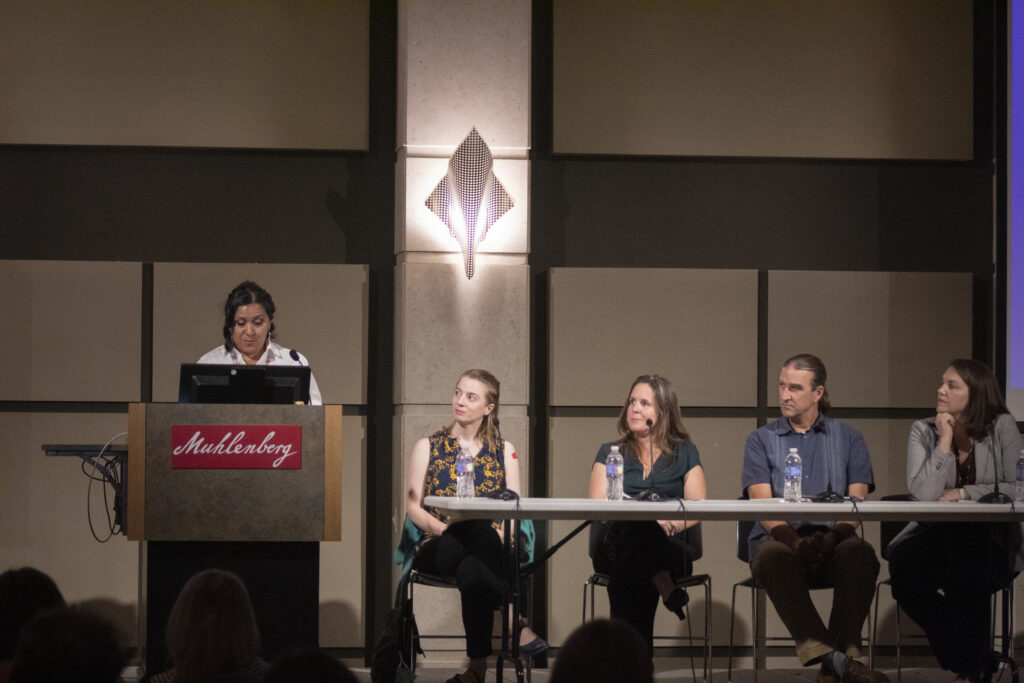On Sept. 4, the Center for Ethics had their opening faculty panel event for this year’s theme, “The Ethics of Repair.” This year’s panel included Assistant Professor of Public Health Kathleen Bachynski, Ph.D., Associate Professor of Theatre Leticia Robles-Moreno, Ph.D., Associate Professor of Anthropology Benjamin Carter, Ph.D. and Assistant Professor of History Sarah Runcie, Ph.D.
Runcie commented that “[I] think this theme opens avenues for everyone on campus to engage. Repair doesn’t mean one thing, but considering the idea of repair through different academic disciplines and from different perspectives gives us an opportunity to think together about urgent social issues.”
Bachynski’s talk focused on her area of expertise regarding her research: brain injuries in sports. In the National Football League (NFL), people who are or were players who have suffered from brain injuries have the right to apply for financial compensation. However, in order to get compensation players would need to go through a group of tests that would be used to test cognition. Due to race-norming, which is adjusting scores based on the ethnicity or race of the test taker, Black players were less likely to get compensated in comparison to white players.
In regards to how this topic fits the theme of “Ethics of Repair,” Bachynski said her topic “links more to the harm of repair rather than a fix of repair. Players, in a certain sense, are being doubly harmed. They are at risk for long-term brain damage. There is another harm that is being added by the process of attempting to get compensation. In this specific example, a racist structure was created to harm people who are not white.”
In 2021, race-norming was eliminated from concussion testing, but there is still significant work that can be done in regards to having fair compensation rights for people of every race in the NFL. Bachynski said that “The process of compensation should be more accessible for all athletes. This is difficult for any person to go through, but this is true especially if they are suffering from long-term brain damage. There should also be more preventative measures in regards to people getting injured while playing.”
Robles-Moreno focused on what theater and art can do to represent repair. She showed various artwork to the audience of the faculty panel about the independence of Peru and stressed that this was a “white-washed” narrative as people of color and Indigenous people were not highlighted despite their importance with the independence of Peru. This is harmful not only to the general population but also minority groups because “In the case of Peru, the epic narratives of the independence wars (the ones that are taught and learned in history books) do not celebrate, or even acknowledge, the role that Indigenous and Afro-Peruvian people, as well as women, played in the birth of the Peruvian nation. That’s why art and performance in particular are so important in redressing this kind of harm: they present possibilities to make visible what has been erased, and to listen to what has been silenced.”
Robles-Moreno also stressed the importance of the work of Peruvian Theatre Group Yuyachkani. Robles-Moreno mentioned that “This group is an example of collaboration and collectivity in many senses: they create complex theatre/performance pieces bringing together different disciplines like history, literature, political science, forensics, anthropology, visual art, etc. I believe that this interdisciplinarity is what we all need to keep in mind from our own contexts in order to develop an ethical and well-informed approach to repair and collective healing.”
Carter’s talk centered on the Lenape. Muhlenberg is situated on part of the Lenapehoking, which is the ancestral lands that the Lenape lived on until the land was unrightfully stolen. In a discussion with The Weekly, Carter stated that “The Lenape groups were pushed west for around 150 years, eventually leaving five different federally recognized nations in Oklahoma, Wisconsin and Ontario, Canada. It was this repeated removal that tore them, repeatedly off the land they knew to increasingly foreign lands where the knowledge they had gained over thousands of years became less and less directly relevant.”
Runcie’s talk centered on the whereabouts of Benin bronzes. This is a distinctive West African art technique that was from the kingdom of Benin, which is in present-day Nigeria. Unfortunately, the Benin Bronzes were unrightfully stolen and placed in historical museums such as the British Museum and the Smithsonian Museum of Natural History. In Runcie’s eyes, she said ““Repair” is a partial synonym of decolonization. In my eyes, repair translates to colonization of Africa in general and how that is harmful. I was hoping it could also show broader themes as well.”
In response to the event, Nola Thompson ‘27 said “I loved that the professor panel at the kickoff event for the Center of Ethics offered up an eclectic range of topics to be discussed. From the NFL scandals to African bronzes, I appreciated the effort to introduce the concept and complexities of repair in so many different facets of our world.”
Brandon Rosenblatt ‘27 echoed similar views, saying, “I thought that the presentation was very informative. I enjoyed hearing the four professors speak about the significance of the issues and how we can work to improve them.”
The event revealed that there are so many different ways to think about repair across geographical locations and different time periods. There are also big world events, such as colonialism, that affect a lot of different things. There’s a lot of big picture themes that can make us think about the ethics of repair in general.

